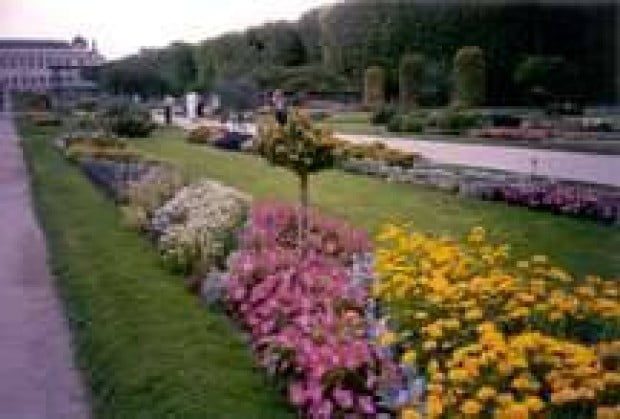When you’ve walked in Claude Monet’s garden at Giverny, gazed at the lily pads from the Japanese footbridge and marveled at sky-high trellises entwined with roses, it’s hard to come home to Southern California’s arid mountain landscape.
I was actually thinking I could incorporate some of Monet’s planting designs in my garden. Well, not the lily pond, of course–Monet got permission to divert water from a river, for Pete’s sake. First of all, there’s no river nearby, and if there were, getting permission to use some of it would bring enough grief from environmentalists to make me give up gardening altogether. And all those trellises would look pretty stupid on my rugged hillsides. Besides, I’ll bet Monet’s six gardeners never had to deal with gophers.
While I was ogling those magnificent French gardens, the gophers were living high on the hostas, so to speak. Just about everything not planted in chicken wire was doomed. Whole tomato plants, two or three feet tall, just disappeared, sucked whole into the tunnels of death. Perennials and annuals alike met their demise: nemesias, marigolds, Shasta daisies, zinnias, cosmos all gone without a trace. I’ve set Macabee traps till my fingers were bloody, installed sonic harassers that drove only me crazy, pumped their tunnels full of truck exhaust (the carbon monoxide did slow them down a bit) and fed them Juicy Fruit chewing gum in quantities that would choke Godzilla. Nada! Zip! Zilch! Nourished by my organic vegetables, the wretched rodents have flourished.
Anyway, the Monet thing won’t fly here because, duh, no water. Still many of the flowers that thrive there can get along with much less rainfall and irrigation.
So here’s the plan. Think Vertical. Forget seed packets that say space 12 inches apart. Plant those puppies so close together they couldn’t spread if they wanted to. Heaven forbid a little dirt might show in between. Monet’s flowers lean on stakes and trellises and walls and each other. And they grow to astonishing heights. Plain old dahlias, planted three or four to a stake, are eyeball to eyeball with the average 12-year-old. And French gardeners aren’t stuffy about mixing them up socially, so to speak–highbrow roses are at nose level with common sunflowers and lowly geraniums and nasturtiums bloom at their feet. Of course, we would never plant invasive exotics like nasturtiums anyway. Would we? Well, maybe only on a rocky, shady hillside that’s 10 miles from the nearest state park.
Another strategy used in the impressionist’s famous garden is to train flowering shrubs into trees, again to bring the maximum floral effect up to eye level. Solanum (potato vine), its delicate purple flowers and creamy centers, and lantana, in all its various colors, are perfect choices for this design. And raising the planting beds, while enriching the soil, also enhances the vertical effect. In Monet’s day, the beds would have been enriched with manure, courtesy of local livestock (or perhaps his own hens).
Monet’s famous green Japanese bridge has been almost consumed by wisteria vines, which must be spectacular when in full bloom. My experience with wisteria is less glorious. Our old ranch house had a wisteria growing up its south-facing wall that sported flashy violet flowers in late spring. It also scraped the shingles off the roof, poked its tentacles in between the clapboard siding and reached out to touch (and strangle) a flowering plum tree nearby. My advice is to forget the wisteria unless you have an old railroad trestle to hang it on or an ugly shed you want to camouflage. Even then, you may someday have to take an ax to it.
In Monet’s garden, century-old trees create a lovely canopy of dappled shade for begonias and impatiens. Those of us who live in newer houses will not likely be able to duplicate that effect, at least not for a decade or two. But it couldn’t hurt to plant a few sycamore or cottonwood and hope for the best. Bon jardin.

